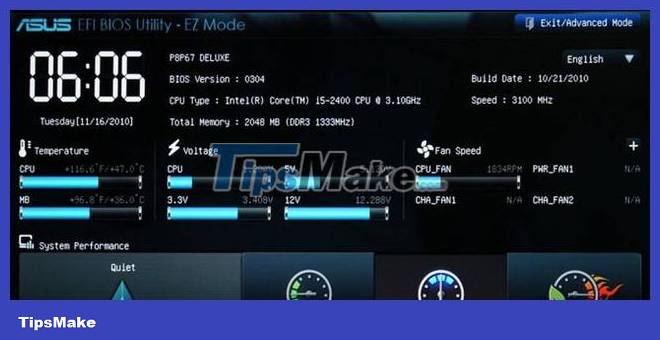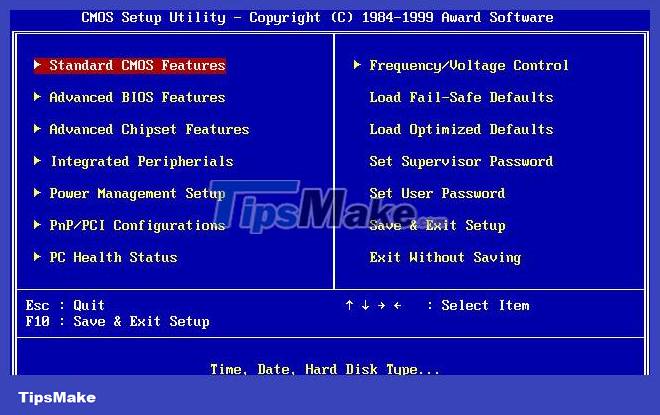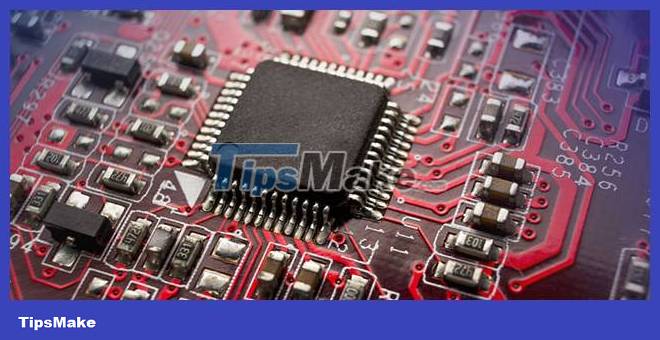5 tips for using BIOS to help you master your computer - What is BIOS and how to use BIOS
Most computer users usually don't care much about BIOS. However when the problem occurs, you need to tweak a setting and don't know what to do. You will wonder what is BIOS? Really need to know about it?
Using a computer while bypassing the BIOS is like buying a TV without accessing the options menu or installing a new router without having to visit the settings page. Most of the time 99% of the time you don't need it, but when you do have to use it, having some basic knowledge about BIOS will help you a lot. Luckily, the BIOS isn't complicated, in fact it's quite easy.
What is BIOS?
BIOS, short for Basic Input/Output System, is the software that runs first when starting a computer. It is stored in a special part of the motherboard, meaning it runs before detecting any other hardware components, including the hard drive.
The BIOS ensures that all connected hardware components are functional and has the ability to run diagnostic tests to help troubleshoot hardware problems. If there are no problems, it will start loading the operating system.

Most BIOSes have a configured boot sequence that starts the computer. This sequence determines the order of devices that the BIOS will check when searching for an operating system. By changing the order, you can boot from devices other than a regular hard drive, for example a USB boot.
An easy but somewhat inconvenient way to access the BIOS is to restart the computer. Then, you press the appropriate BIOS hotkey for your system. This hotkey is listed in the motherboard manual.
If you can't find it, you can use common BIOS access keys such as F1, F2, F10 and DEL. However, it really depends on the manufacturer and model of the computer, so it takes some trial and error to find the right hotkey to access the BIOS on your computer.
Difference between BIOS and UEFI
UEFI, short for Unified Extensible Firmware Interface, is newer firmware, inherited from BIOS, that acts as an interface between hardware components and the operating system. Although it is said to be a replacement, most UEFI configurations that provide Legacy support the BIOS.
The most notable difference between UEFI and BIOS is the graphical display. While operations performed on modern BIOS still rely on an ASCII text-based display, UEFI uses advanced graphics that are more attractive and comfortable to use.

Not only that, you can also use keyboard and mouse with UEFI. Other features include advanced tools for diagnosis and repair, detailed boot order configuration, faster boot time, and enhanced boot security. The Secure Boot feature prevents the system from running malicious code in case the UEFI has been infected.
In short, you can think of UEFI as a new and improved BIOS version. Starting with Windows 8, computers that came with Windows had UEFI installed in place of BIOS.
5 tips when using BIOS
Find the BIOS version
There are several ways to find your BIOS version, but the simplest is to open the Run window (use the Windows key + R key combination ) and enter msinfo32 . This will open the System Information tool.

In the System Summary section, scroll down and find BIOS Version/Date . You will also know about the SMBIOS version whether your computer is operating in BIOS or UEFI mode. Knowing the BIOS version is very important when updating the BIOS.
Update BIOS
Occasionally, manufacturers will release updates to BIOS firmware that can fix bugs, improve performance, or even add new features. Compare your version with the manufacturer's latest version (which you can find on their website) and perform a BIOS upgrade if necessary.

Note: Whenever you update (or "flash") the BIOS, make sure you follow the manufacturer's instructions without any deviation. Because if there are any errors, your system will stop working.
Set up hardware password
If security is a big concern for you, then you should consider password protecting the BIOS. This prevents anyone from changing BIOS settings without your permission. You can also set a password on your hard drive through the BIOS.

Note: There is no way to easily recover, reset or delete a password, so only proceed with setting up a hardware password if you are absolutely sure that this is what you want.
Power management features
Most modern BIOSes have one or more power management features, usually accomplished through CPU scaling. Each manufacturer often uses different terms such as 'CPU Frequency Scaling' or 'Demand-Based Scaling'.
Regardless of what it's called, this feature changes the speed of the CPU based on how much processing needs to be done. For example, if you are playing a game, the CPU will operate at 100%. If you pause, the CPU will gradually decrease. It's a good way to save power, especially for laptops.
However, if you plan to overclock your CPU, you can skip this feature as it may give undesirable results.
Restore factory settings
If the worst happens, you can restore the BIOS to default settings. It will be called "Reset to Default" or " Reset to Factory Settings" or something similar depending on the terminology used by the computer manufacturer.

BIOS is a tool, once you know what it is capable of doing and how to use it, you will be able to maximize your computer's performance and much more.
 How to install Windows on WinPE - Fast installation speed, limited errors
How to install Windows on WinPE - Fast installation speed, limited errors Summary of Windows installation errors on computers - On Windows 7/8/10
Summary of Windows installation errors on computers - On Windows 7/8/10 How to create USB MultiBoot with Ventoy, create USB Boot very easily with Ventoy
How to create USB MultiBoot with Ventoy, create USB Boot very easily with Ventoy Learn about Windows ghost software Onekey Ghost
Learn about Windows ghost software Onekey Ghost Download Ghost Windows 11 Pro 21H2 Full Soft v7.0 Best Standard 2022
Download Ghost Windows 11 Pro 21H2 Full Soft v7.0 Best Standard 2022